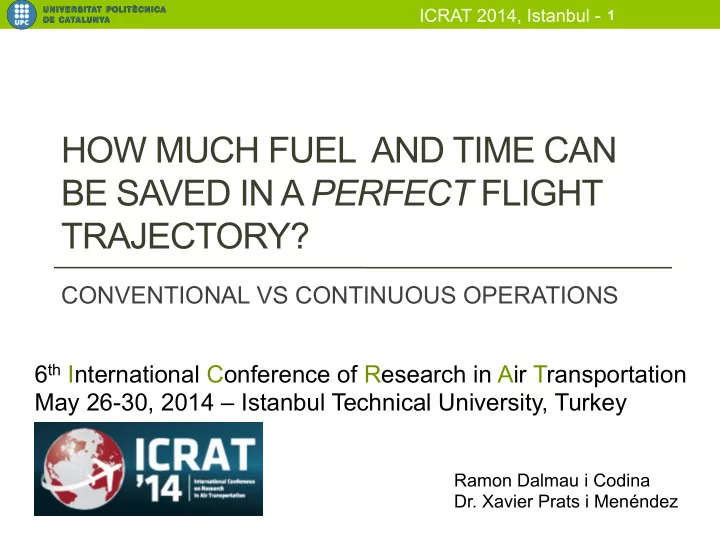

ICRAT 2014, Istanbul - 1 HOW MUCH FUEL AND TIME CAN BE SAVED IN A PERFECT FLIGHT TRAJECTORY? CONVENTIONAL VS CONTINUOUS OPERATIONS 6 th International Conference of Research in Air Transportation May 26-30, 2014 – Istanbul Technical University, Turkey Ramon Dalmau i Codina Dr. Xavier Prats i Menéndez
ICRAT 2014, Istanbul - 2 What can be considered a perfect flight trajectory? • Reducing fuel consumption (and therefore emissions) is perhaps one of the main concerns of the different aviation stakeholders
ICRAT 2014, Istanbul - 3 Continuous operations = perfect trajectories CRUISE CLIMB Continuous climb Cruise climb CDA Continuous descent
ICRAT 2014, Istanbul - 4 Conventional operations = inefficient trajectories Constant cruise altitudes ROC ≥ 500 ft/min Interrupted climb Level off during descent FL100 Minimum rate of climb Speed limitations FMS segments at constant CAS or Mach
ICRAT 2014, Istanbul - 5 How much fuel can be saved by flying such perfect trajectories? - = ?
ICRAT 2014, Istanbul - 6 Optimisation of an aircraft trajectory is a multi-phase constrained optimal control problem Solved using numerical methods
ICRAT 2014, Istanbul - 7 Optimal control problem formulation Direct collocation methods Continuous problem Discrete NLP
ICRAT 2014, Istanbul - 8 Optimal control problem formulation FL100
ICRAT 2014, Istanbul - 9 Optimal control problem formulation
ICRAT 2014, Istanbul - 10 Optimised trajectories 99% of maximum landing mass. 87% of maximum landing mass. 600 NM trip distance. 2400 NM trip distance. CONTINIOUS OPERATIONS FOLLOW THE CRUISE CLIMB .
ICRAT 2014, Istanbul - 11 Cruise climb Aircraft burns fuel Aircraft mass decreases Lift needed is reduced Drag is reduced Thrust required is lower
ICRAT 2014, Istanbul - 12 The optimal procedure consists in maintain the optimal throttle setting and the optimal cruise speed using the excess thrust to slowly climb the aircraft • 87% of maximum landing mass. • 1600 NM trip distance.
ICRAT 2014, Istanbul - 13 Why conventional operations are flying below the perfect flight trajectories? The minimum rate of climb mandated by ATC
ICRAT 2014, Istanbul - 14 Increasing altitude Excess thrust decreases Climb phase Rate of climb performance decreases Aircraft burns fuel Excess thrust increases Cruise phase Rate of climb performance increases Step climb to the next flight level Step climb
ICRAT 2014, Istanbul - 15 As the minimum rate of climb is reduced conventional operations are able to fly at higher and more fuel-efficient altitudes. • 87% of maximum landing mass. • 1800 NM trip distance.
ICRAT 2014, Istanbul - 16 Experimental setup Scenario i LM ∈ [0.71 MLM ,0.99 MLM ] LM i DIST i DIST ∈ [400 NM ,2400 NM ] Continuous Conventional Airbus A320 operations operations Fuel and time comparison
ICRAT 2014, Istanbul - 17 Total trip fuel needed Continuous operations Conventional operations From 71% to 99% of maximum landing mass. From 400 NM to 2400 NM.
ICRAT 2014, Istanbul - 18 Fuel savings of flying perfect flight trajectories Relative fuel savings Up to 300 kg representing Absolute fuel savings the 2% of the total trip fuel!
ICRAT 2014, Istanbul - 19 • 94% of maximum landing mass. • 2000 NM trip distance.
ICRAT 2014, Istanbul - 20 Fuel savings are mainly achieved by the possibility to fly a continuous cruise climb. CRUISE CLIMB CDA CCO In the simulations conventional operations are allowed to perform continuous climb and descent
ICRAT 2014, Istanbul - 21 Time savings of flying perfect flight trajectories Relative time savings Up to 16 min representing Absolute time savings the 5% of the total trip time!
ICRAT 2014, Istanbul - 22 More fuel-efficient and faster operations Minimum rate of climb + engine limitations Flying at lower altitudes Flying at lower optimal speeds More time and fuel!
ICRAT 2014, Istanbul - 23 Conclusions. Remarkable figures in terms of fuel consumption , mainly for longer routes . Continuous operations not only reduce fuel consumption , but also the trip time ATC complexity Fuel Time savings savings
ICRAT 2014, Istanbul - 24 Conclusions. New avionic systems will be able to support trajectory-based operations in the forthcoming years. Aircraft themselves will be responsible for keeping separation amongst each other POSSIBILITY TO FLY CONTINUOUS OPERATIONS
ICRAT 2014, Istanbul - 25 Conclusions. Aircraft usually fly The cost of the time is also at higher speeds considered for flight planning. CDA are not usually performed. Climbs are usually interrupted. Fuel savings of continuous operations would be even larger. This work quantified the minimum benefits that could be achieved by flying perfect flight trajectories.
ICRAT 2014, Istanbul - 26 Future works. Study long-haul aircraft ( A340 ) Sensibility study on the influence of real weather scenarios (e.g. winds effects)
ICRAT 2014, Istanbul - 27 THANK YOU! Any question?
Recommend
More recommend